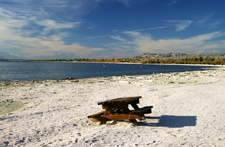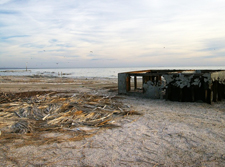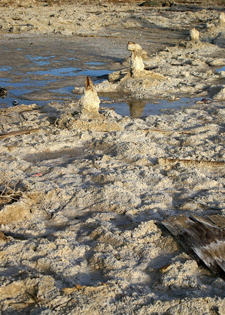The impact of Salton Sea water management on air quality
Summary:
The Salton Sea, the largest lake in Southern California, provides critical wildlife habitat. While it was once part of a vast inland sea, more recently water in the lake has come largely from irrigation runoff and leaching. Efforts to conserve and recycle agricultural and municipal water, along with water transfers, have decreased the amount of water flowing into the lake. As a result, water in shallow areas is receding, exposing the dry lakebed, or playa, underneath. This newly exposed playa releases dust, especially during the winter months. The additional source of particulate matter in the air is a concern in the area, which currently exceeds California and National Ambient Air Quality standards. The results of this research provided baseline chemical characteristics of dust emissions, and are valuable in understanding the impact of current water management practices and the effectiveness of mitigation practices.
Investigator:
Roya Bahreini
Assistant Professor, Department of Environmental Sciences
University of California, Riverside
Project description:
The Salton Sea is a highly saline and eutrophic lake in Southern California which has served as an important habitat for wildlife during the past century. With the increased imbalance between evaporation and water input to the lake, driven by water conservation, recycling, and transfers, water in shallow areas of the Sea is receding, exposing the playa underneath. Newly exposed playa has become a concern as an additional source of dust emissions in an air basin that is currently an area of non-attainment for California and National Ambient Air Quality standards.
In 2013, a comprehensive Monitoring and Assessment Plan of the Salton Sea Ecosystem Restoration Program was developed by a team from California Department of Water Resources, California Department of Fish and Wildlife, U.S. Bureau of Reclamation, U.S. Geological Survey, and academic institutions. A report from the Focused Technical Group on air quality identified chemical characteristics of suspended dust particles at the Salton Sea as one of the critical information needs. Without chemical characterization of the airborne particles, it is difficult to assess the impact of particulateemissions to address the potential effects on human health and agricultural crops at downwind receptor sites, and to identify areas where further actions to reduce dust emissions are needed.
This project measured aerosol composition using offline chemical analysis of particles collected onto filter samples, in different size bins. Measurements were conducted at Salton City, located on the southwestern shore of the Salton Sea, to determine the impact of temperature and humidity fluctuations on contribution of playa dust emissions to airborne particles. Results provide baseline chemical characteristics of dust emissions in the area. This is valuable for understanding the impact of current water management practices on emissions of trace elements and salt, examining the effectiveness of current mitigation practices, and identifying other areas where new mitigation and water management practices might be needed to reduce emissions of potentially harmful elements.



Exposed playa of the Salton Sea.
(all photos Faith Kearns)
